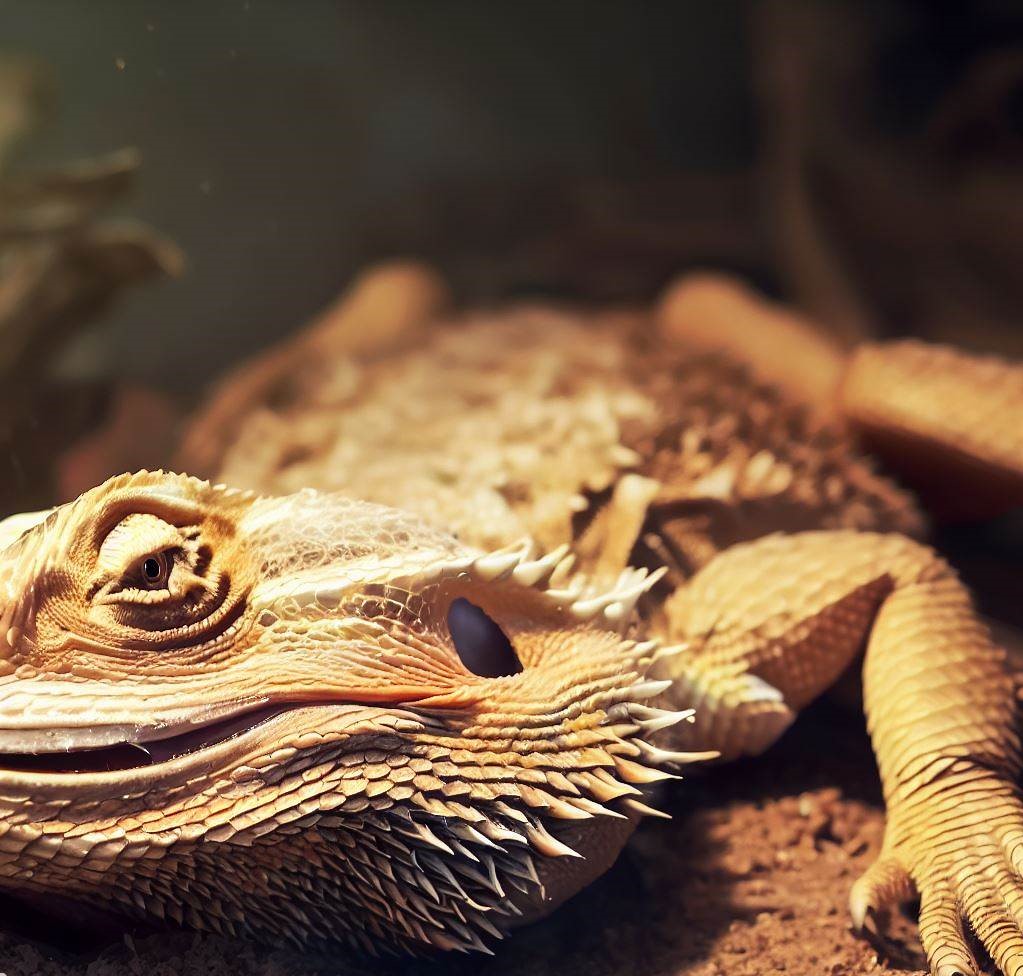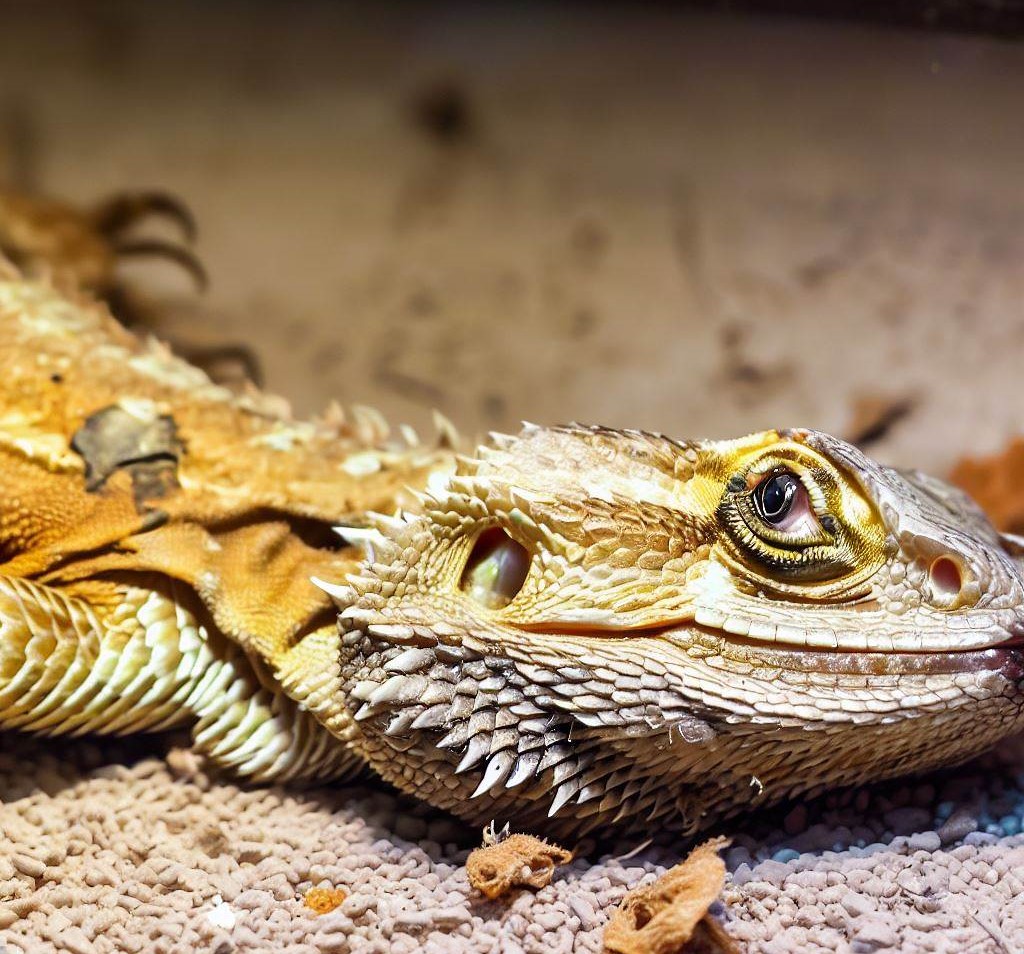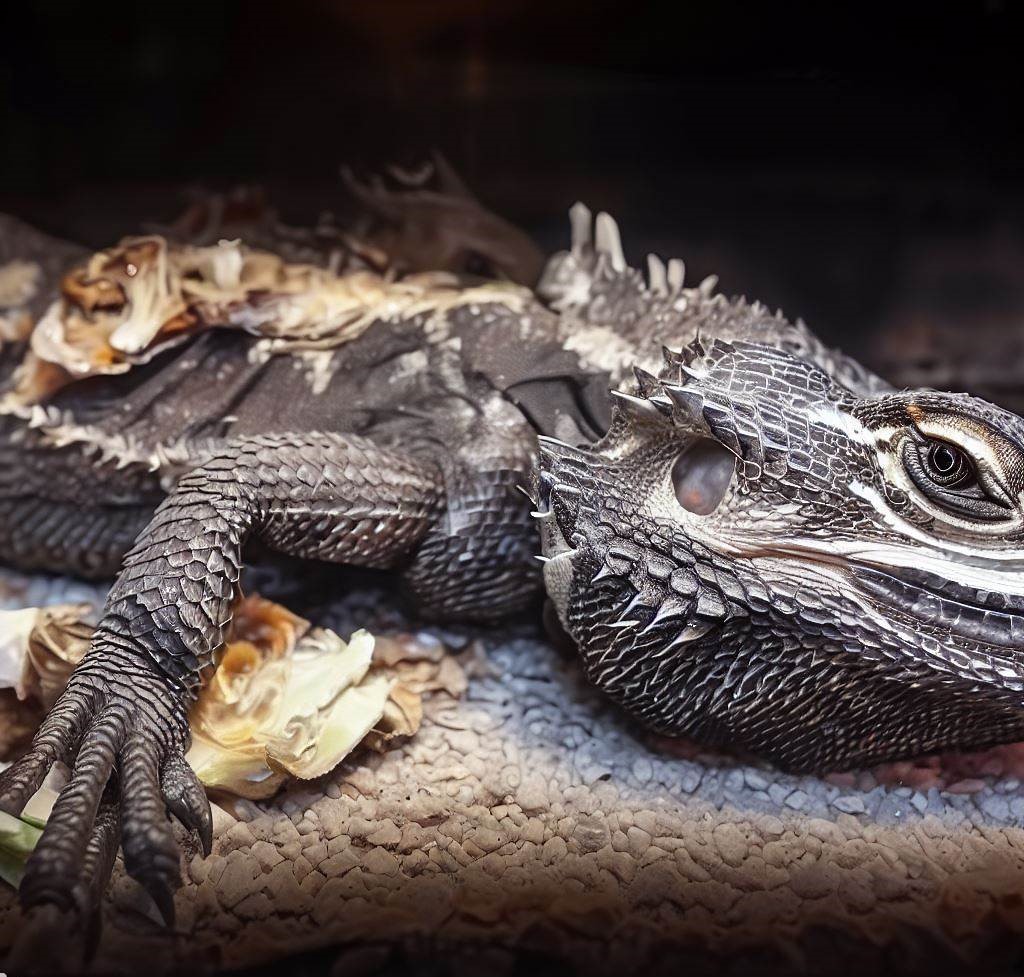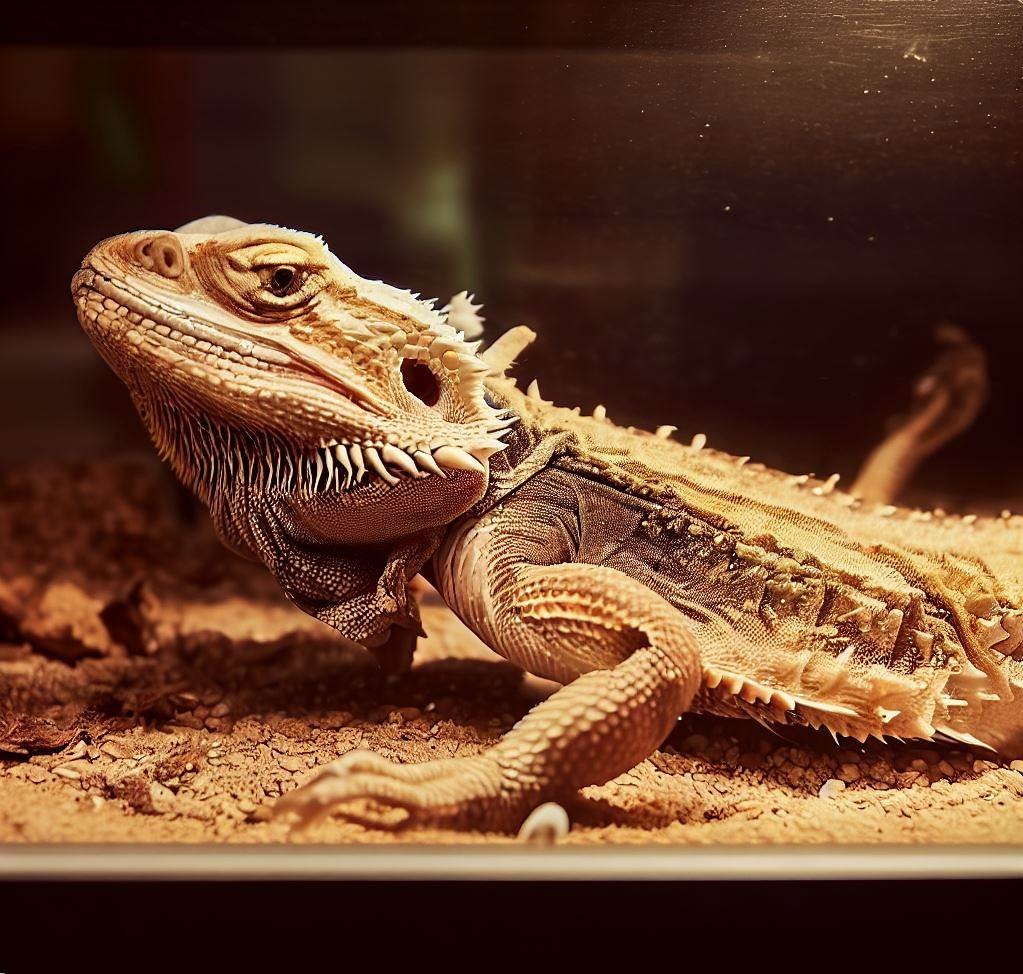While we wish for our beloved bearded dragons to thrive and live long, healthy lives, it is an unfortunate reality that they, like all living creatures, are vulnerable to sickness and aging.
Recognizing the signs of a dying bearded dragon is crucial in ensuring that we can offer them the proper care and support during their time of need.
In this blog post, we will delve into the key indicators that may suggest a bearded dragon is nearing the end of its life and preventative measures you can take to keep them comfortable as they age.
Table of Contents
Common Signs That Your Bearded Dragon Is Dying

Recognizing signs of a dying bearded dragon is vital for responsible pet ownership. Understanding both physical and behavioral aspects will help you stay informed to identify signs of illness and ensure the well-being of your beloved dragon as they age.
Physical Symptoms
Physical symptoms are valuable signs that can help in the early stage of illnesses. Staying alert and taking quick action upon noticing these symptoms can greatly increase the chances of your bearded dragon surviving.
Regarding your bearded dragon’s health, it’s important to know about physical symptoms that can help in the early stages of illnesses. Recognizing these common signs can help you provide appropriate care and support during this difficult time.
By staying observant and knowledgeable about these physical indicators, you can offer the best possible care for your beloved bearded dragon during this challenging stage of its life.
Loss of Appetite and Weight Loss
A major symptom of an ailing bearded dragon is a sudden lack of interest in food. Ordinarily, Bearded dragons love to eat and are very excited about their meals. They often dive headfirst into their food with great excitement.
If your dragon begins to shy away from food, it could mean serious health problems. Closely linked to this is weight loss. A reduction in your dragon’s weight, particularly if rapid and unexplained, could be a sign of a dying bearded dragon.
Regular check-ups on your pet’s weight and health checks is important to catch any issues early.
Unusual Color Changes (particularly turning black)
One physical symptom to watch out for in your bearded dragon is unusual color changes, especially if they start turning black. Such color variations can indicate underlying health issues that require attention. It’s common for pet owners to think back on the heartbreaking moment their bearded dragon turned black and died unexpectedly.
Understanding the importance of these color changes can make all the difference in your pet’s preventative treatment. Notice your bearded dragon’s color shifting to black? Seek veterinary guidance promptly to address potential health concerns. Monitoring color changes helps ensure your cherished pet’s well-being.
Inactivity and Lethargy
Have you noticed a decrease in your bearded dragon’s usual activities? Is it spending more time lazing around and less time exploring its habitat?
A healthy bearded dragon should be curious and alert about its environment. Lethargy, inactivity, or sluggishness can often be signs of an illness.
If you observe this symptom, be sure to reach a veterinarian immediately.
Difficulty Breathing or Wheezing
Respiratory issues are common in bearded dragons that are suffering from health problems.
Consider immediate veterinary care if your pet has difficulty breathing or producing wheezing noises.
This could be a sign of a respiratory infection, which can be severe if not treated.
Diarrhea or Vomiting
Digestive problems like diarrhea or vomiting in bearded dragons should be treated as red flags, as they are not normal bodily functions. These issues can lead to dehydration, which can be fatal in severe cases.
If you observe these symptoms in your bearded dragon, it’s crucial to seek veterinary consultation as soon as possible to ensure their well-being. Being vigilant and taking prompt action when you notice these physical symptoms can be life-saving for your bearded dragon.
Behavioral Changes
In addition to physical symptoms, your bearded dragon’s behavior changes can also show potential health issues. As owners, we grow to understand and recognize our pet’s typical behaviors. Any significant deviations from these norms should be cause for concern.
Aggression or Defensive Behavior
Bearded dragons are known for their generally docile and friendly nature. If your usually mild-mannered pet suddenly becomes aggressive or defensive, it can signify distress or discomfort. Unusual aggression can be a reaction to a variety of health issues.
Change in Posture
A healthy bearded dragon holds itself up high off the ground. It has a strong, steady grip and a straight tail. But a bearded dragon that’s consistently hunched over or appears limp could be unwell.
So, if you notice your bearded dragon with a weak posture or dragging itself around, seek professional help.
Clear Signs Of A Dead Bearded Dragon

Losing a pet is a heart-wrenching experience. In the unfortunate moment of a bearded dragon dying, clear signs can help you recognize and come to terms with the loss and understand what has happened.
To reduce confusion and support understanding, we’ll deeply examine these signs to assist you during such a tough time.
Loss Of Coordination Or Difficulty Moving
When a bearded dragon is alive and healthy, they exhibit coordinated movements and have no trouble navigating their environment.
- Unsteady movements
- Inability to walk or climb
- Lack of mobility
When you notice these symptoms in your bearded dragon, it is a clear sign of a dead bearded dragon, unfortunately. Loss of coordination and difficulty moving are strong indicators of their demise.
Lack of Breathing
Breathing is a common denominator of life, applicable to every living creature, including bearded dragons. If the rise and fall in your dragon’s body, which signifies its breathing rhythm, ceases, it can sadly indicate that your pet has passed on.
If your bearded dragon lies motionless for an extended period without noticeable breathing, it’s a heartbreaking and clear sign of a dead bearded dragon.
No Heartbeat or Pulse
Like any living creature, bearded dragons have a unique heartbeat that signifies their vitality. However, detecting their pulse can be challenging due to their small size and unique anatomy.
To check for a pulse in a bearded dragon, gently place your fingers behind its front legs on the underside of its body. Apply slight pressure without causing any discomfort to your dragon.
You should feel a rhythmic pulsation similar to checking your own pulse. Keep in mind that a bearded dragon’s pulse is relatively weak and may be difficult to detect, especially for those with limited experience.
If, after multiple careful attempts, you are unable to feel a palpable pulse or detect a heartbeat, it could be an unfortunate sign of your bearded dragon dying. Don’t lose heart; continue your efforts, but be prepared for the possibility of their unfortunate demise.
Cold Body Temperature
As ectothermic creatures, bearded dragons rely on their environment to regulate body temperature. If your bearded dragon continuously feels cold to the touch, even with access to a suitable heat source, it is a definitive sign of their unfortunate passing.
Discovering your bearded dragon in a continuously cold state can be an incredibly distressing experience. It is essential to know that temperature imbalances can greatly affect their health.
In some cases, when bearded dragons are severely affected by critical temperature imbalances, they can even develop a dark or blackened coloration before passing away.
Stiff or Rigid Limbs
One particularly stark and distressing sign of a bearded dragon’s death is the stiffening or rigidity of its limbs.
If you observe that your bearded dragon’s limbs have lost their usual flexibility, it’s a sign that your pet might have sadly passed away. This lack of motion is an alarming yet clear sign of death.
Glassy or Dull Eyes
A living creature’s vigor and vitality often reflect in its eyes, and bearded dragons are no exception.
If your bearded dragon’s eyes lose their sparkle and get a glassy or dull look, it’s a clear sign of life’s departure.
Witnessing a bearded dragon dying with its eyes open and its luster lost is heartbreaking. But it is a clear sign of its passing.
Eyes Open Without Movement
One clear and definitive sign that a dead bearded dragon show is having its eyes open without any movement.
Normally, when a bearded dragon is alive and healthy, their eyes will be responsive, blinking, and moving as they observe their surroundings.
But, if you notice that your bearded dragon’s eyes are open and remain completely still, it clearly shows that they have unfortunately died.
Common Causes Of Illness Or Death In Bearded Dragons

Being a good pet owner means knowing what can make your bearded dragon sick or even cause death. Learning about this can be tough, but it’s very important. It helps you keep your bearded dragon healthy for a long time.
By knowing what can cause health problems, you can avoid these risks, give your pet a safe place to live, and make sure they stay well.
To help you with this, we will look at common things that can hurt a bearded dragon’s health.
These include things in their environment, not getting the right food, infections, bugs that can make them sick, diseases, problems they were born with, and issues that arise as they age
Each area has its own set of problems. Knowing about them is the first step in stopping health problems before they start.
Environmental Factors
The environment where your bearded dragon lives are essential for its health conditions, such as the wrong temperature or humidity levels, which can cause significant discomfort to these cold-blooded creatures.
Inadequate or excessive heat can lead to problems, including poor digestion, lethargy, and even burns. Similarly, low humidity levels can result in dehydration, while high humidity can increase the risk of fungal infections.o
Also, an improperly set up enclosure might need to provide more space or opportunities for the necessary physical activity.
Mismanaged environmental conditions, if prolonged, can severely affect their health, leading to a situation where your bearded dragon might be at risk of dying.
Nutritional Deficiencies
Providing the right diet is critical for the health of a bearded dragon. They need a balanced mix of vegetables, insects, and occasional fruits to live. Lack of certain essential nutrients can quickly lead to health problems.
For example, a calcium deficiency, a common issue among bearded pet dragons, can result in metabolic bone disease. This painful condition can severely affect their quality of life and even prove fatal if not addressed promptly.
Infections, Parasites, or Diseases
Infections, parasites, and diseases can be the silent assassins in the life of a bearded dragon. These often remain unseen until too late, leading to many health issues.
For instance, stomatitis, an infection in the mouth, or coccidia, a common parasitic condition, can cause enormous harm to your bearded dragon’s health.
Regular vet check-ups can help detect and treat such conditions early, possibly preventing your bearded dragon from dying.
Congenital Issues
Sometimes, bearded dragons might be born with congenital problems or health issues resulting from their genetic makeup.
These problems can reduce their lifespan and are often outside the pet owner’s control.
While unfortunate, it’s important to understand that congenital issues do not reflect your care or love for your pet.
Old Age
It’s essential to know that old age is a natural cause of death in bearded dragons. These intriguing creatures usually live between 10 to 15 years.
As they reach their twilight years, their health can deteriorate, and they may experience various age-related problems. Even with the best care, they might eventually pass on due to natural causes.
Preventive Measures For Bearded Dragon Health
Like any other pet, bearded dragons need attentive care for optimal health. Identifying issues before they escalate into major problems is essential.
Here are some preventive measures you can take to ensure your bearded dragon remains in good health.
Seek Veterinary Care Immediately
Acting swiftly and seeking veterinary care can often significantly determine whether it’s a minor or more severe health issue.
Also, scheduling regular check-ups with a reptile veterinarian can help identify potential problems before they become serious. Watching your pet and getting professional treatment if anything appears abnormal is important.
Properly Maintain and Clean the Enclosure
Bearded dragons are sensitive to their environment, and a dirty enclosure can lead to a host of health problems. Proper maintenance of their habitat is essential to their overall health.
This includes regularly removing waste and leftover food and changing the substrate as needed. A clean enclosure can significantly reduce the risk of bacterial or parasitic infections.
Provide Appropriate Nutrition and Temperature Gradients for Your Bearded Dragon
Ensuring your bearded dragon has access to a diverse range of nutritious food is a cornerstone of their well-being. It’s not just about quantity but quality.
Their meal plan should include a well-balanced combination of leafy greens supplemented with protein-rich insects. Adjusting portion sizes and content according to their age is also key.
Creating the right temperature gradient is equally vital. Bearded dragons like different temperatures. So, you should make one side of their enclosure hot for basking and keep the other side cooler. This temperature management helps them regulate their body heat.
Monitor Their Behavior Closely
Observing your bearded dragon’s daily habits and behavior can provide insight into their health. Changes in behavior, such as decreased activity, loss of appetite, or a sudden color change, could indicate a health issue.
Remember, prevention is the first line of defense for maintaining your bearded dragon’s health.
Conclusion
Facing the inevitable reality of a dying or dead bearded dragon is a challenging experience for any pet owner. But by recognizing the signs and taking timely action, you can make a significant difference in your beloved companion’s health and well-being.
While you play an important role in their care, it’s crucial to acknowledge the natural cycle of life. As difficult as it may be, witnessing your bearded dragon’s final stages or bidding them farewell is a part of this journey.
Treasure the precious memories and cherish the moments that have made your lives richer together.
FAQs
Can bearded dragons show signs of grief or depression?
While not as emotionally complex as humans, bearded dragons can show signs of stress, which could be interpreted as grief or depression. These signs may include loss of appetite, lethargy, or change in their usual behavior.
How long can a bearded dragon go without eating?
Bearded dragons can go without eating for up to 2 weeks, but this isn’t healthy. Prolonged refusal to eat can show serious health problems, requiring immediate veterinary attention.
What is brumation in bearded dragons, and how does it affect their behavior?
Brumation is a natural hibernation-like state that bearded dragons enter during colder months. During this period, they may eat less, sleep more, and be less active. This can often be mistaken for illness or lethargy, so it’s essential to understand and recognize the signs of brumation.
Alina Hartley is a small-town girl with a ginormous love of bearded dragons. It all started with Winchester, a baby bearded who was abandoned at the shelter by his former owners because of a birth defect that caused one front leg to be shorter than the other. Alina originally went to the shelter looking for a guinea pig, but one look at Winchester and it was love at first sight. From that day on, Alina has dedicated her life to learning everything she can about bearded dragons. She loves helping new beardie parents start their incredible journey with these magnificent reptiles.
Follow her on:
LINKEDIN
TWITTER.
Read her latest articles HERE
Learn more about her HERE.

